Drawing on years of eCommerce experience, we’ve compiled a list of the best strategies we’ve seen.
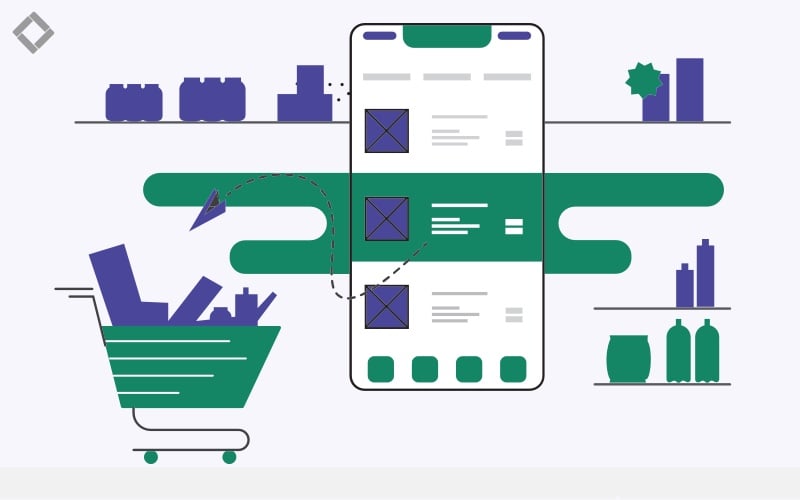
Drawing on years of eCommerce experience, we’ve compiled a list of the best strategies we’ve seen.
Imagine you show up to a party where you don’t know the host nor 80% of the party attendees.
You brought wine - they prefer whiskey.
You wore a suit - the dress code is tropical.
You make a bad joke about The Beatles just as the host plays Ob-La-Di, Ob-La-Da and everyone sings along.
Nobody is a fan of this scenario.
It’s awkward, unfortunate, and you’ll end up alienated from everyone or kicked out. Ob-La-Di, Ob-La-Da - life does not go on.
The same applies if you’re a retail marketer without an excellent eCommerce marketing strategy in place.
25.6% of the world’s population buy online, and in 2021 the number is said to rise to over 2.14 billion! That’s a lot of party people who may end up hating or (worse) not even remembering you.
Successful eCommerce marketing strategies start with understanding who your audience is, what they like, and how your products can intervene in their lives to fill a gap and provide a benefit.
You may need some examples. How about thirty?
This article will provide you with thirty successful eCommerce marketing strategies. Rest assured that these marketers showed up to this party looking fly.
And with a little help from your friends (that’s us) you can too! No more faulty drink choices, awkward suits, or bad jokes.
Instead, taking these examples to heed into your own webshops, you’ll be able to optimize your UX, personalize your customers’ journeys, enhance your brand image, increase eCommerce sales, and confidently level the playing field.
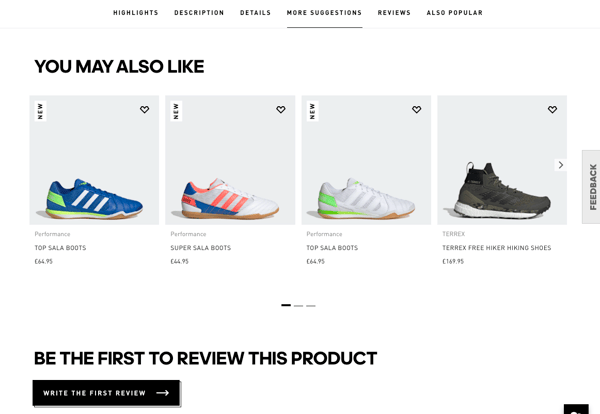
Product recommendations are good for cross-selling. And recommendations based on what your shoppers have seen will show users that you understand their shopping needs.
Adidas does this well by recommending the same product in different colors and styles, plus one extra shoe with similar characteristics.
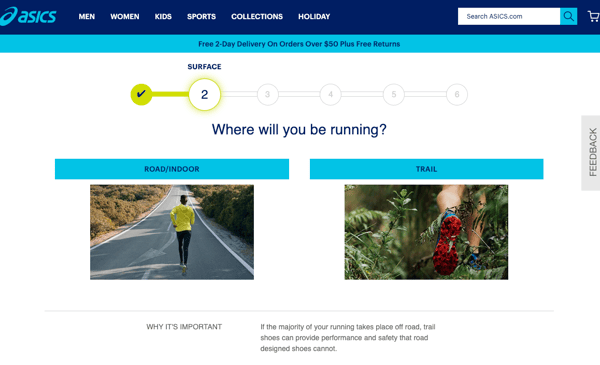
Another way you can help your customers find the perfect product that fits their needs is by asking them. Simply put, a quiz like ASICS’ Shoe Finder finds a running shoe based on the options the customer clicks on.
Quiz wizards do three important things:
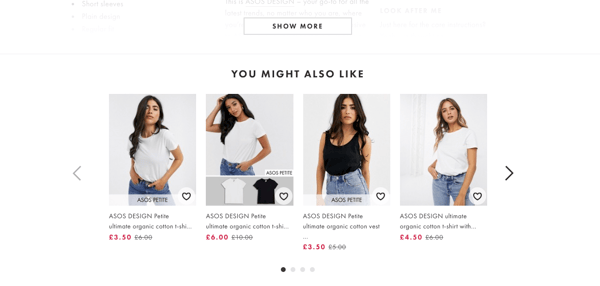
You can also provide recommendations that are similar to the one being bought like ASOS does above.
This strategy provides the shopper with the autonomy to view and compare the current product with what’s in stock for potential cross-selling but also helps in their decision-making (but be warned: too much choice may inflict paralysis).
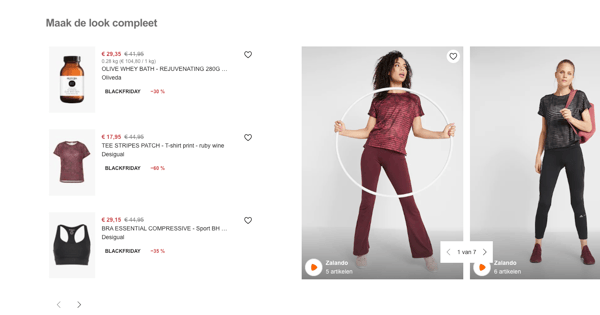
The best webshops will go one step further and provide recommendations based on completing the outfit, leveraging the psychology of Set Completion (you can read all about marketing psychology in this post for more examples).
Notice what’s unique about the Zalando example above?
While shopping for yoga clothes, one of their recommendations to “complete the look” is an olive bath oil. While this isn’t strictly clothing, Zalando’s strategy here is to recommend a complete wellness experience that goes hand-in-hand with yoga - hence essential oils.
This strategy:
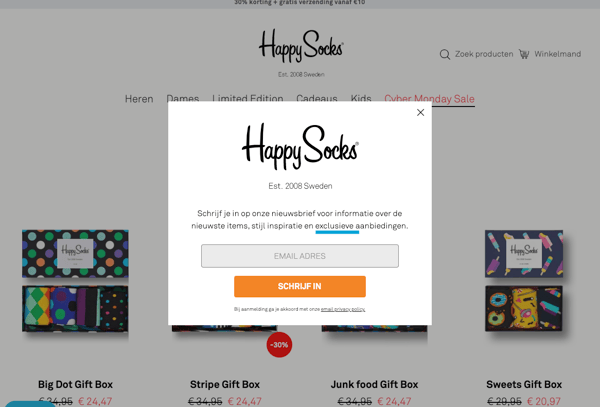
In order to prevent bounce, you should use exit-intent overlays. These could:
In this Happy Socks exit-intent overlay they offer the opportunity to stay in touch by newsletter.
The “exclusive offer” promise in the copy also leverages Exclusivity Scarcity, the psychology that people respond to things that are scarce with more purchase-desire.
Psychological principles will elevate your exit-intent copy (triggers that a behavioral scientist called BJ Fogg would appreciate) and in the long run drive conversions.
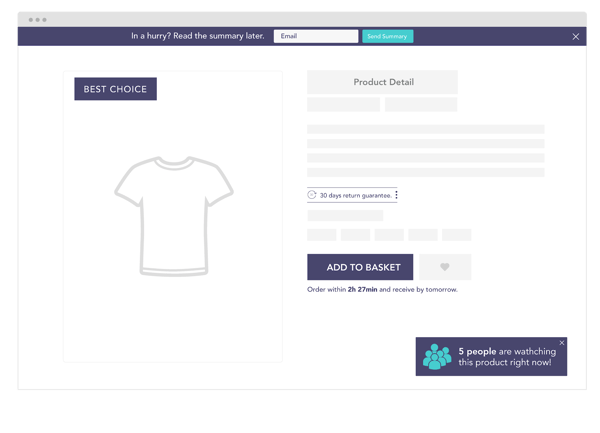
Another trigger you can capitalize on is smart notifications. For effective impact, these can be shown on your product detail page (PDP) to highlight if a product is in demand, a bestseller, or has a particular USP you want to push.
In this mockup, Social Proof is leveraged to drive purchase behavior, showing how the t-shirt is desirable because it’s popular.
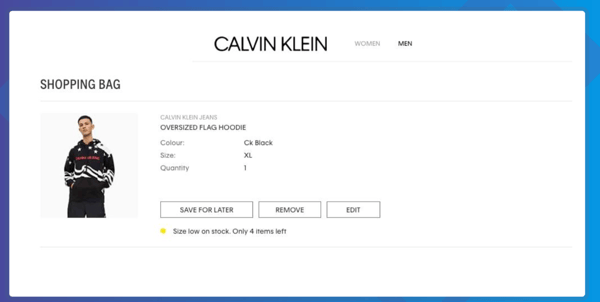
Cart nudges are implicit cues that drive behavior towards checkout. In the Calvin Klein example above, the nudge implies that the product is in limited stock, thereby urging shoppers to buy now.
As all nudges imply behavior, cart nudges onsite should not be too forceful or this will just interfere as the shopper browses your webshop, or views a product.
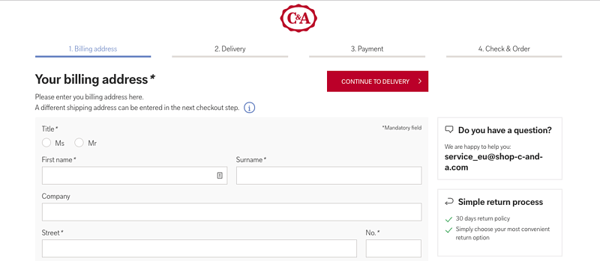
Nudge marketing will boost your eCommerce marketing strategies overall. And these can be implemented from your homepage to checkout.
In this C&A example, they leverage the Goal Gradient effect with the progress bar on the top of the page. The Goal Gradient says if people can see how close they are to their end-goal, their speed will quicken. This will increase your conversion rates in the long run and is a non-intrusive way to nudge your customers through checkout.
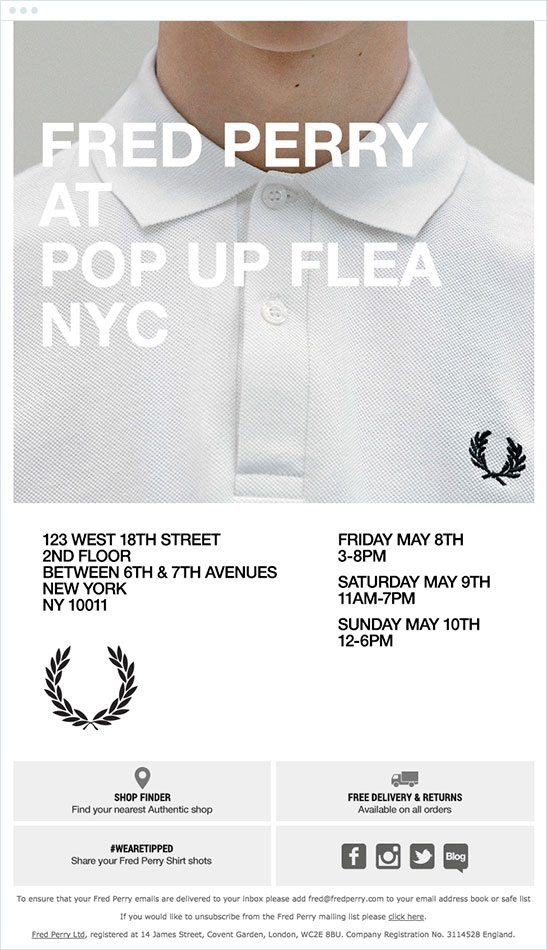
Targeted email marketing campaigns take into account customer data like demographics in order to tailor campaigns to where the customer lives and shops. For example, this Fred Perry email is for New Yorkers.
For similar targeted marketing you could:

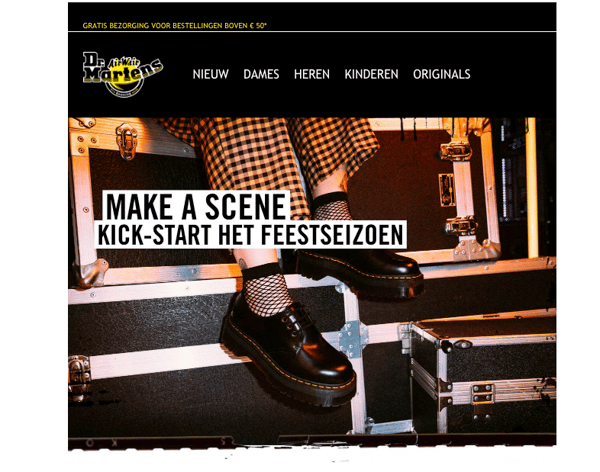
Another way to leverage email campaigns for better eCommerce marketing is by releasing more general announcements to your customers that represent your brand identity.
Of course, these should be less frequent so as not to overload your customers’ inboxes. This Dr. Martens email campaign is a good example of a clean campaign that reinforces their branding: wearing their boots makes you original, and are perfect for the holidays (pushed in early November in the Netherlands: “Kick-Start the Festive Season”).
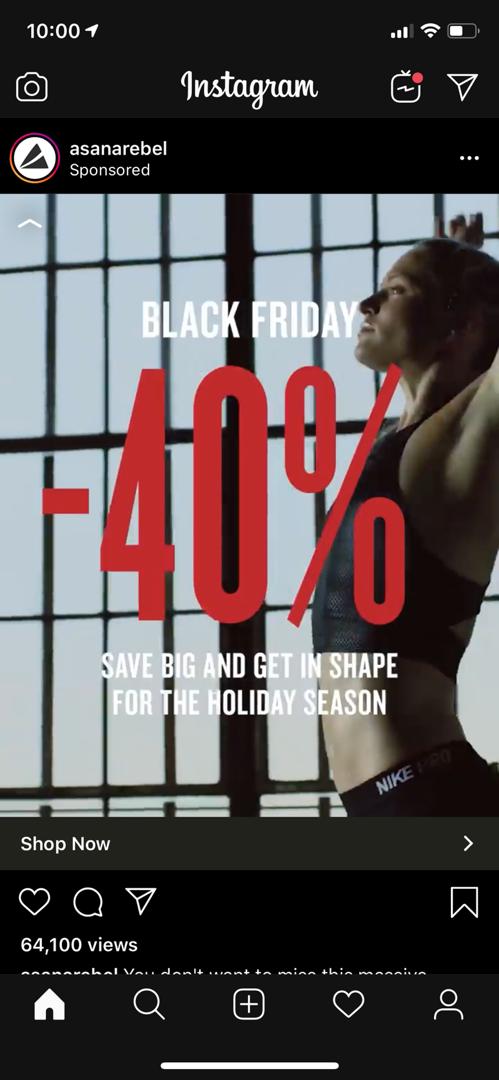
As a modern-day eCommerce platform you’ve already been using Instagram ads, right? 75% of users take action from Instagram ads so I have no doubt this is already part of your strategy.
These allow you to:
Instagram ads cost somewhere between 20 cents and $2 CPC (cost per click) for campaigns. 1 billion people use IG every month globally.
Need I say more?
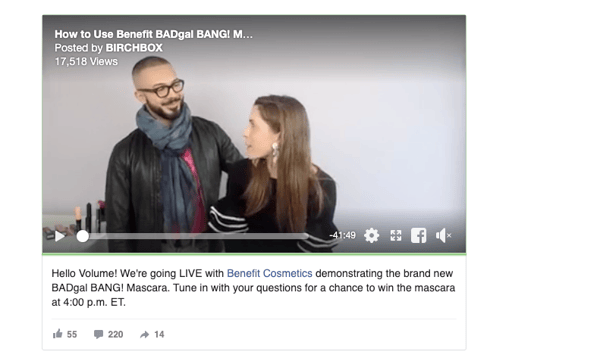
For a more low-cost eCommerce marketing strategy, try Facebook Live. This is another great strategy that allows you to connect with your users in real-time.
You can use Facebook Live in several ways:
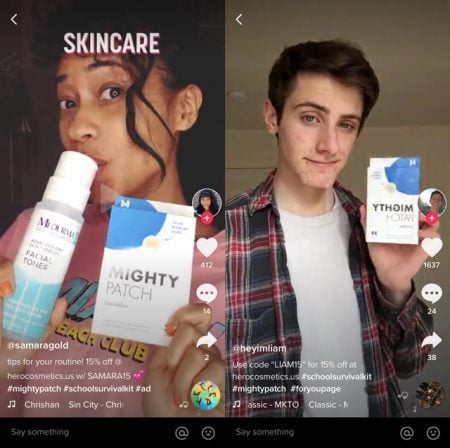
Speaking of languages your target audience will understand, if you are selling to Gen Z or younger you may want to check in on TikTok. This subculture is one of the fastest-growing social media platforms in the world. Marketers should look to capitalize on this trend quickly.
For example, Hero Cosmetics has been popularized by TikTok: the brand carried out mature market research that revealed that their target audience (teenagers) were increasingly using TikTok.
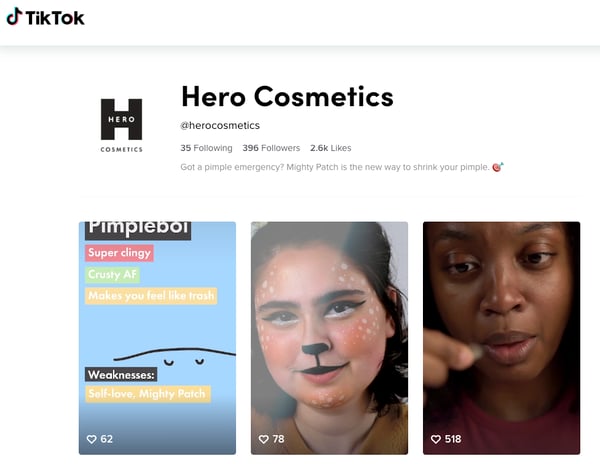
Since 66% of TikTok users are below the age of 30, this platform has proved to be the best platform for the acne-prevention brand to target. In the end, TikTok helped Hero Cosmetics double their sales just by using 10-second videos!
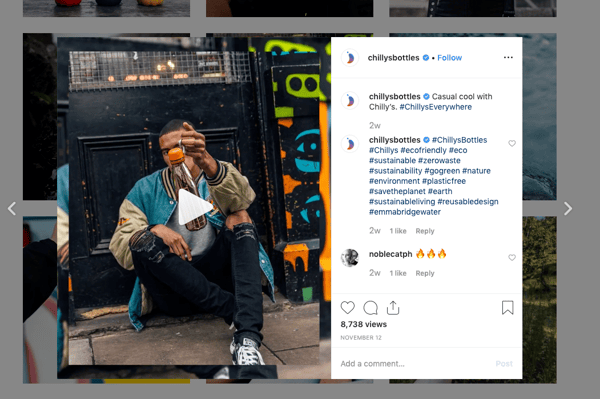
I know we’re talking a lot about social media. But you can’t have a successful eCommerce marketing strategy if you ignore these important platforms.
Micro-influencers have between 1,000 to 1,000,000 followers, but those who follow them are loyalists. Sending out a free product to one micro-influencer could help you reach brand awareness for 1k potential customers.
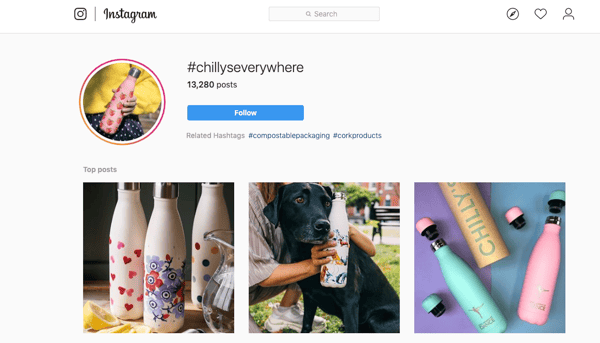
The psychology of influencers ties in with social identity theory, attractiveness, likeability, and credibility - all of which are things you want your brand message to be associated with.
Chilly’s leverages these mindsets by exposing IG users to their marketing. Result? Their #chillyseverywhere is now a trending hashtag.

Celebrities will also help your brand achieve maximum awareness while boosting your credibility. However, there’s a caveat: not all celebrities will resonate with your target audience.
For celebrity influencer marketing to work you should:
H&M used Katy Perry as a fun approach to the Christmas season in 2015. Yet many saw the Katy Perry commercial as disturbing since it failed to resonate with a single target audience (was it for kids? Adults? Whatever the target demographic I think we can all agree it was just plain creepy).
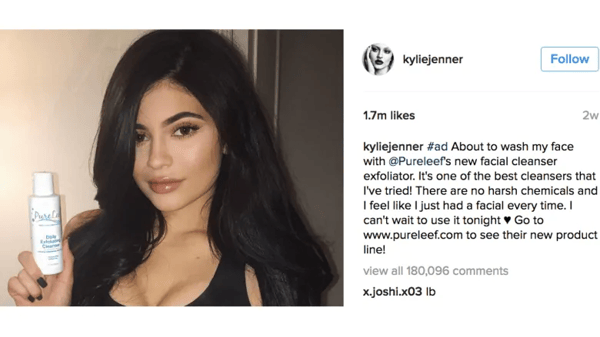
Instead, what works for Pureleef (above) is to have a minimal strategy that nonetheless targets the millions of followers Kylie Jenner has on Instagram - all she does is to hold up one of their products.
Sometimes less is more, especially when celebrities are already social media influencers in their own right.

Mobile apps are a great way to apply your eCommerce marketing strategies omnichannel. Yes, I said it: that buzzword you hear time and time again when discussing eCommerce marketing and customer intelligence.
If you want more hard-stats on omnichannel marketing, have a look at this report by Omnisend.
Nike’s Plus app, for example, charts fitness goals whilst at the same time acting as a loyalty program giving out points for purchases, as well as product recommendations.
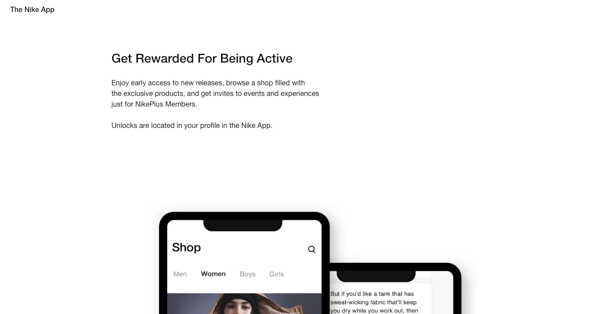
This fits in line with their general mission of selling benefits in the form of wellness, whilst bringing their products closer to their customers.
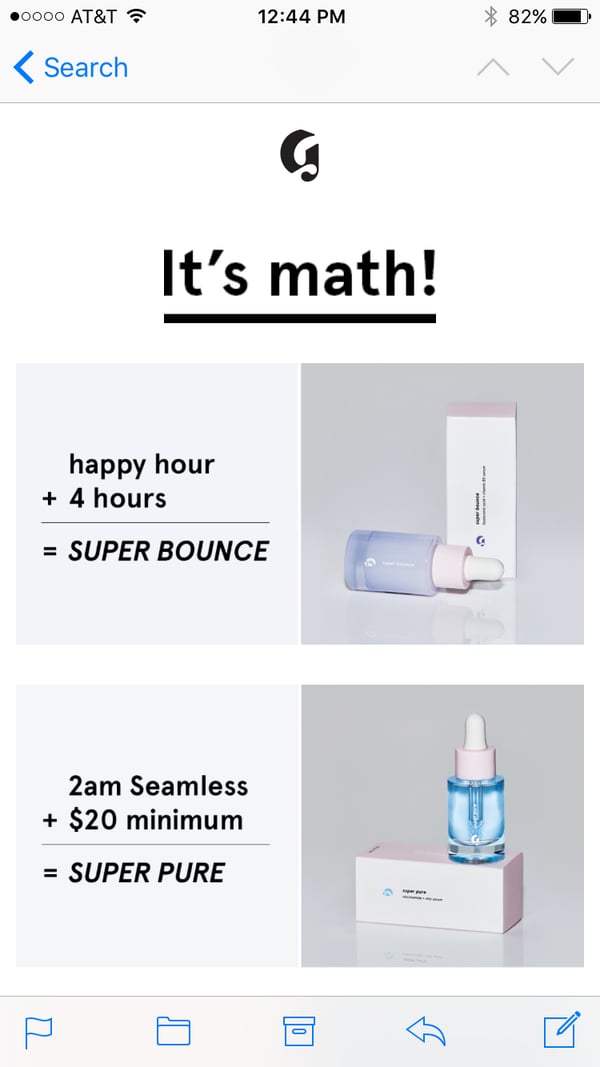
On the other hand, Glossier is an online D2C retailer, which means they can get creative in their marketing. When Glossier first launched its skin tone matcher tool, for example, this was done exclusively through a blog post.
Hello, disruption.
Their matcher tool works kind of like a sample sale in brick-and-mortar makeup stores would, yet since this is exclusively online it saved Glossier tons of money and allowed them to reach a larger audience at scale.
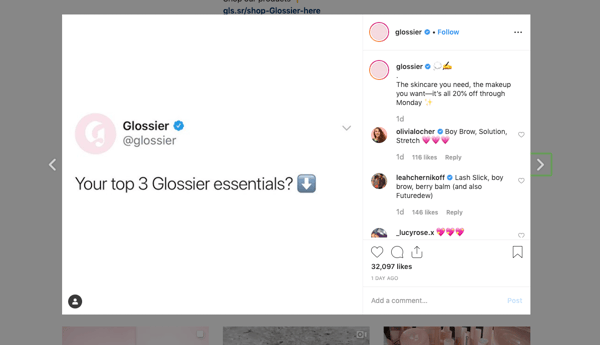
Glossier’s strategy, from their social media marketing to their webshop always keeps the customer in mind, using a conversational tone of voice that is unique to the brand.
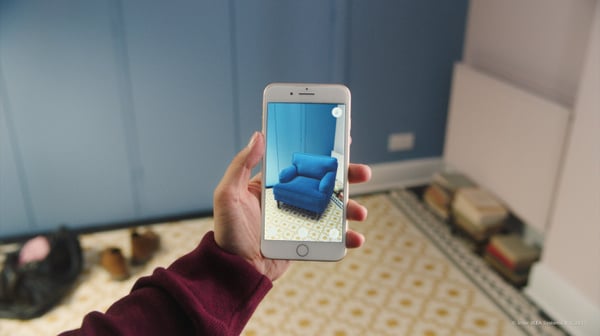
What’s important for marketers is: which technologies can make your communication and products more customer-centric?
IKEA’s AR app “Place”, for example, allows customers to visualize how furniture would fit within their living spaces, leveraging the Endowment Effect (a powerful tool that allows IKEA customers to make better, more well-informed purchase decisions).
If you want to excel by acquiring new technologies, then the best way to go about it is to put yourself in your customer's shoes and think: how would this better their lives?
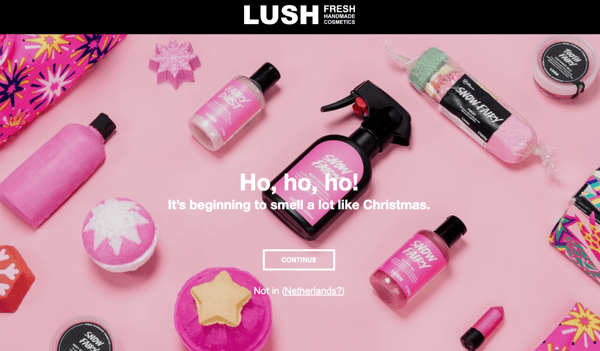
At every most wonderful time of the year (because for marketers, there’s always more than one, Yipee!), your consumers will be looking to give gifts, shop for their fresh start, or cash in on some seasonal offers or discounts.
This Lush homepage banner capitalizes on Christmas because Lush understands that their audience is primarily gift-givers (in 2017, the Lush webshop crashed ahead of the company’s boxing day sale...this you should avoid, of course, meaning always prep your website for traffic influx).
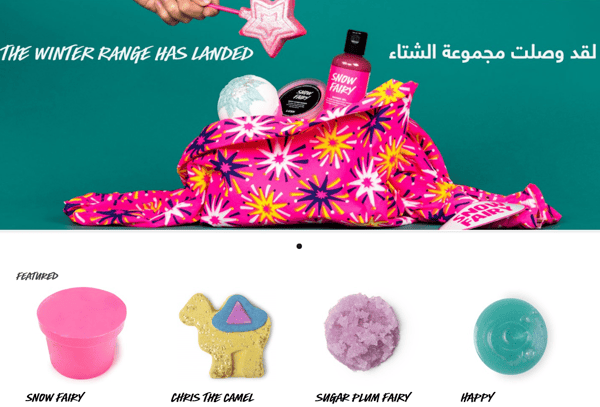
In order to promote your products in line with the seasons, it’s important to know who’s visiting your webshop. For Lush’s webshop in Saudi Arabia, they change their Christmas marketing to Winter, since the country doesn’t celebrate Christmas.
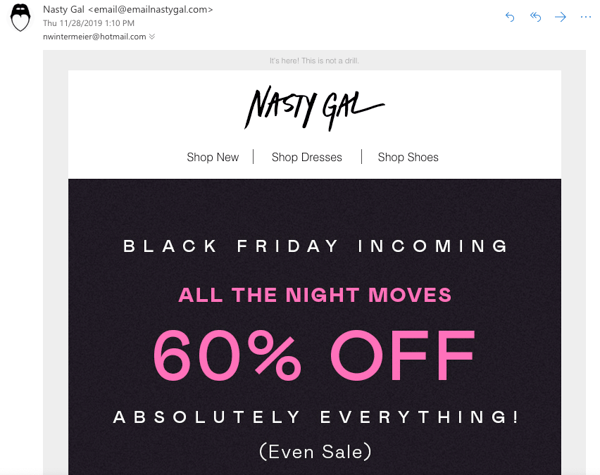
Speaking of seasonality...what better way to capitalize on mass discounts, mass customers, and mass sales than by pre-promoting Cyber week as your yearly marketing strategy.
NastyGal promotes Black Friday through an email campaign, seeing as they are a pure player (check out this post on Black Friday eCommerce strategy for more!). So it depends on your target-demographic what channel you use for your seasonal marketing but whatever you decide, Black Friday/Cyber Week will always be one of your biggest marketing events.
You should prep your eCommerce marketing strategy accordingly.
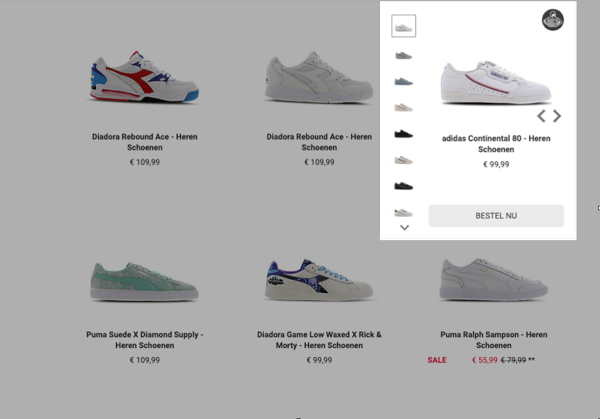
Scarcity or, in other words, fostering a sense of urgency to drive purchase behavior, is a psychological principle that can also be highlighted in product tags like, “selling fast”, “few left”, or “limited time offer”.
Alternatively, Footlocker places a more subtle “exclusive” badge on their special shoe. This will appeal to shoppers looking for Exclusivity Scarcity when they shop and is a good strategy that can further help you segment your audience by their psychographic profiles (e.g. email marketing segment grouping people who respond to Novelty together).
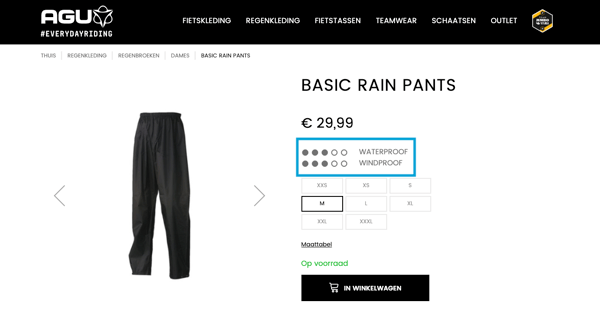
Moreover, you can highlight the functional attributes of a product, as Agu does. They even show the extent of their products’ functionality - or just how waterproof and windproof their rain pants really are. I like this strategy because it gives the shopper the information they need to make an informed decision.
When customers arrive on the PDP they are looking for more information on the product. This is a good chance to highlight product benefits as this is likely to drive conversions.
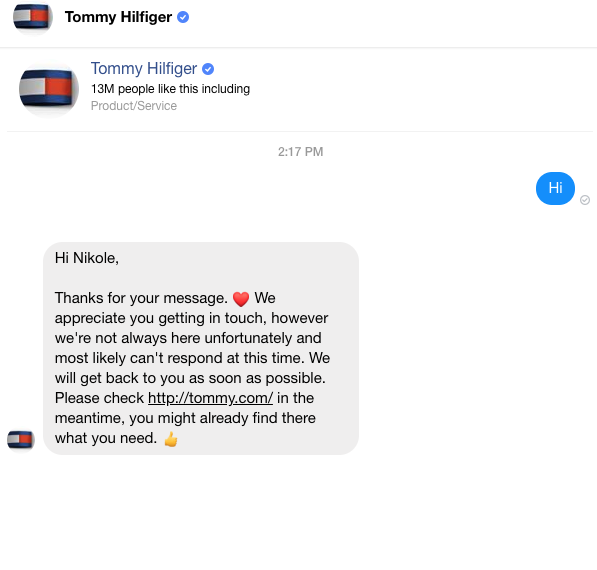 Some of the biggest retailers have chatbots (H&M, Tommy Hilfiger, Sephora, eBay, Burberry, etc.), as these are automated processes that enhance the CX. Tommy Hilfiger, for example, connects their chatbot through Facebook Messenger.
Some of the biggest retailers have chatbots (H&M, Tommy Hilfiger, Sephora, eBay, Burberry, etc.), as these are automated processes that enhance the CX. Tommy Hilfiger, for example, connects their chatbot through Facebook Messenger.
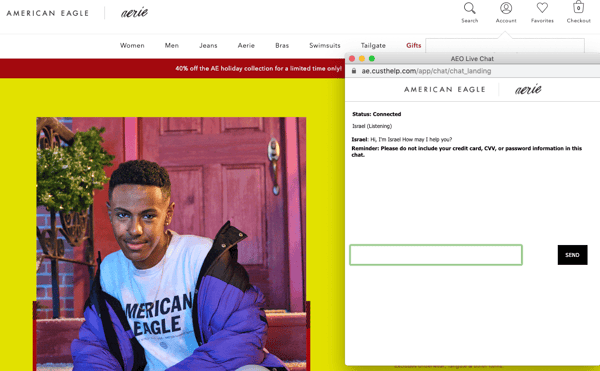
American Eagle’s Aerie also automates customer service, saving them time and money that traditional call-centers may use up. Bigger retailers are now acquiring AI innovations like chatbots to help them disrupt and stay relevant to their customers.
On that note...
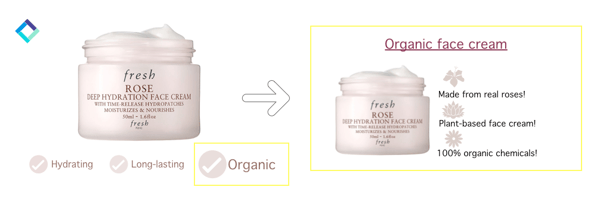
Another great eCommerce marketing strategy is to highlight your high-performing product attributes and then push this in your marketing campaigns.
So if you are selling face cream, and you track that the highest performing tag on the product is its “organic” attribute, then you can tailor a whole ad-campaign around this.
Of course, this data can be difficult to track and analyze . To do this, we run AI-driven multivariate tests to understand which product attributes are most likely to drive purchase behavior so you can reuse those insights in other marketing channels.
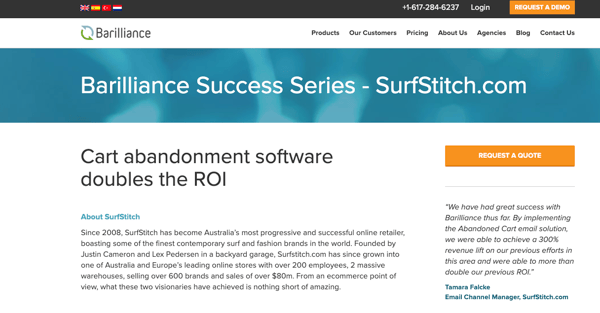
We all know that cart abandonment is your number one frustration, and sometimes (like collecting product data), it can be hard to handle by your marketing team. So SurfStitch hired Barillance to automate cart abandonment emails for them.
The more you can automate processes that help you retain and retarget customers, the more mature your eCommerce marketing strategies will become.
This means you can focus your time and energy on making the most out of your customer data to provide your shoppers with clean and seamless experiences of your webshop and products.
There are about 5000 MarTech tools out there, so it's important to find the right one that actually moves the needle when it comes to cart abandonment. You’ve heard this before, but for our purposes, it still applies: when it comes to eCommerce tools, it’s all about quality over quantity. So be sure to do your research.
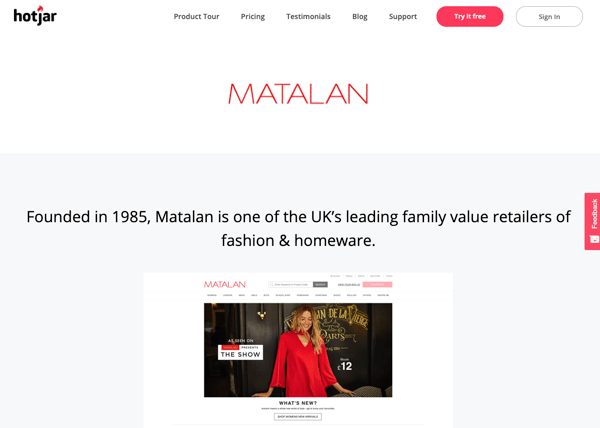
You can use heatmaps to gain a better idea of how people are using your website so you can optimize your pages.
Hotjar, for example, helped the fashion retailer Matalan improve their checkout conversions by +1.23% after they used a heatmap to see where people dropped off.
You can use heatmaps to monitor:
These features will help you to understand the intent behind abandoned sessions, and especially how to fix these for a better eCommerce experience.
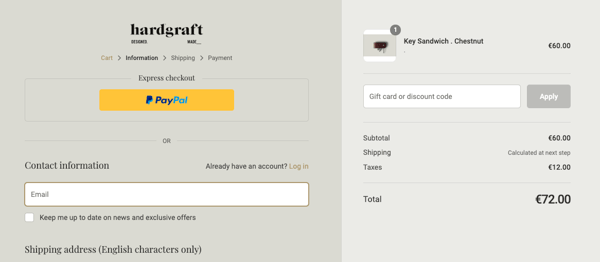
Easier checkouts = higher conversion rates. Amazon’s one-click checkout is the quintessential example of a frictionless payment.
But since Amazon has a patent on their one-click, another way you could provide an easy checkout is by offering different payment options.
For example, Hardgraft offers an express checkout using PayPal. Considering there are 295 million PayPal accounts worldwide, this is a great alternative to the patented one-click checkout.
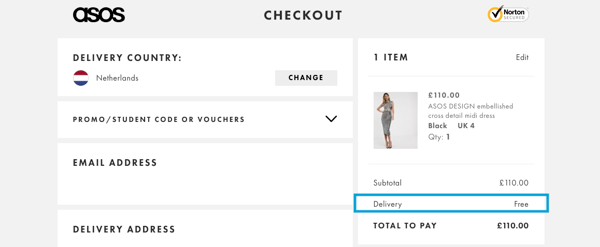
Free shipping is a must-have for a successful eCommerce website. It’s a tactic that leverages Reciprocity whilst significantly alleviating the pain of paying (see: ASOS).
Instead of paying for shipping at checkout, incorporate the extra costs in your product prices. Psychologically, this eases tension within your shoppers, removing hesitation at checkout.
Free returns are another way to nudge your customers in the right direction if they know they can try the product before making their minds up.
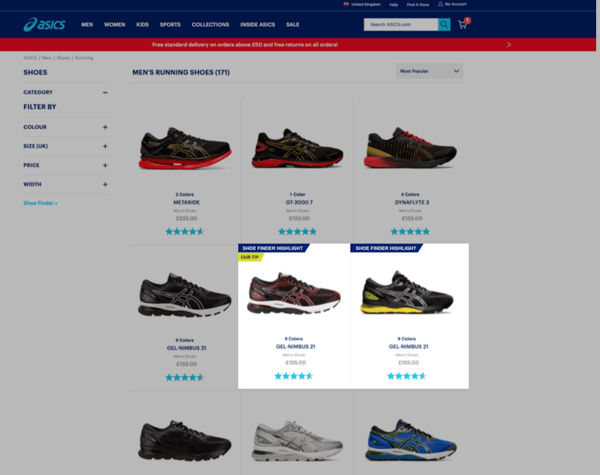
You can also retarget shoppers onsite by serving certain messages, offers, or previously view products.
For example, we did this for Asics. Remember their Shoe Finder quiz wizard that was mentioned earlier? After collecting data from the Shoe Finder, Asics retargeted them with the suggested products.
So shoppers that took the quiz saw a “shoe finder highlight” label that directed their attention to the shoes that were revealed as the best options for their running needs.
There are a lot of retargeting eCommerce marketing strategies out there, but when done right, on-site retargeting show dynamic messages that react according to who is visiting your webshop. This is a personalized product-experience that customers will love.
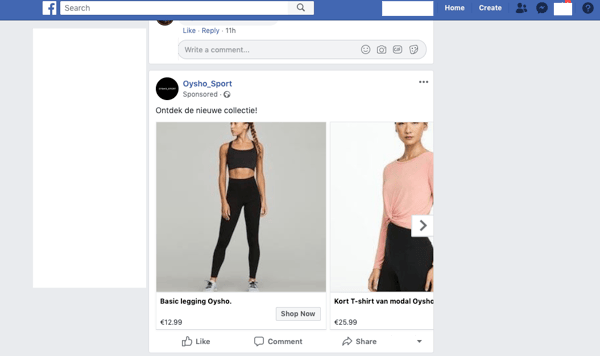
Of course, you should also look to retarget your webshop visitors on social media with the help of a tracking pixel. The more exposure of your products = the more your consumers will think about you.
Retargeting can also help decision-making by exposing your customers to better prices, similar products, or (like Oysho on Facebook) new collections.
Of course, these types of nudges should be subtle and implied, rather than overloading the customer. Aggressive retargeting will eventually cause resistance to the product - something you definitely don’t want.
You’ve made over 2 billion new (online shopper) friends. You come groovin’ up slowly.
People love your brand. You're the star of the party!
There’s no shortage of great eCommerce marketing examples we could show to help you grow into the best version of yourself.
However, these examples will have hopefully showed you how the best eCommerce marketing strategies start with the customer, adapt with the times, yet remain consistent and creative.
Ob-La-Di, Ob-La-Di, life can now (finally) go on.